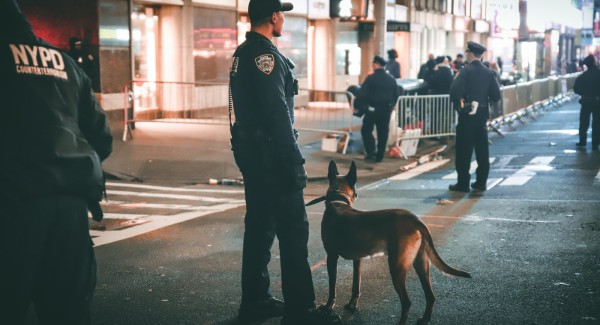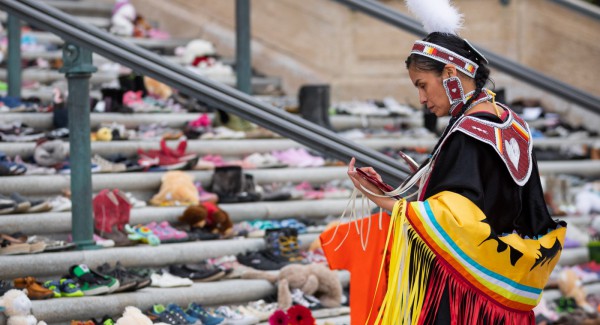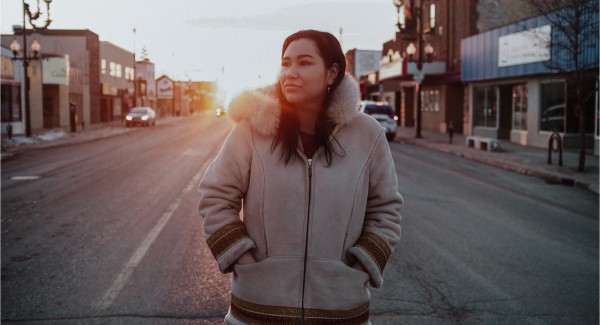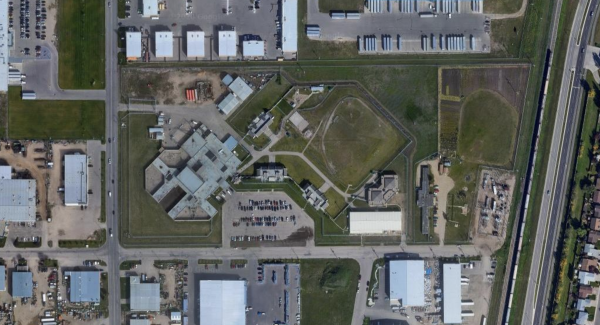The reality of Saskatchewan’s colonial violence
The recent attack on Colby Tootoosis is not an isolated incident, but rather part of the ongoing struggle between Indigenous people and settler colonialism in Saskatchewan
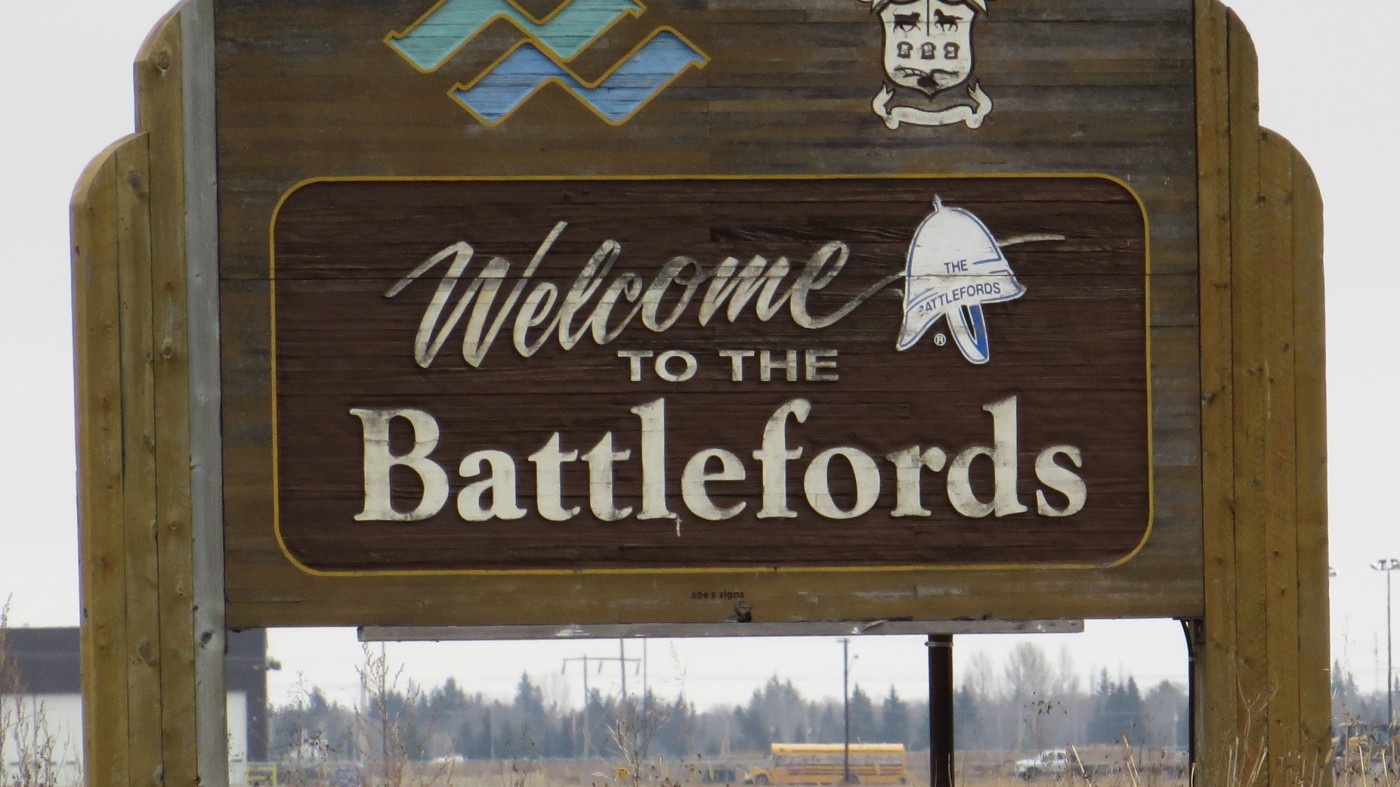
The Battlefords have earned their name as a site of monumental struggle between Indigenous nations and the intrusion of settler colonialism. Awmcphee/Wikimedia Commons
There are few places in Saskatchewan – both historically and in the present – that better exemplify the evolution of Indigenous-settler relations than the Battlefords region. The region once served as the Canadian government’s operations base during the North-West Resistance, and has been a flashpoint in the ongoing struggle between Indigenous Peoples and colonizers. Most recently, Battleford was where Colby Tootoosis, a Cree man from Poundmaker First Nation, was assaulted by white settlers in an unprovoked attack that happened in front of his six-year-old daughter.
Consisting of the city of North Battleford on the north side of the North Saskatchewan River and the town of Battleford to the south, the Battlefords have earned their name as a site of monumental struggle between Indigenous nations and the intrusion of settler colonialism.
An ongoing struggle with a historical basis
From the earliest point in the history of European contact in the Plains, almost two centuries before Saskatchewan was called Saskatchewan, the area was home to fur trading outposts where Europeans traded with Indigenous nations – relationships that, if not friendly, were at least practical.
In 1875, six years after the Dominion of Canada purchased Rupert’s Land from the Hudson’s Bay Company in preparation for mass settlement in the region, Battleford was founded, and in 1876 became home to a North-West Mounted Police (NWMP) outpost. Here, the NWMP would maintain their offensive against the Indigenous communities whose knowledge and trade had long kept Europeans in the area alive.
The Battlefords have earned their name as a site of monumental struggle between Indigenous nations and the intrusion of settler colonialism.
As Indigenous-European relations transitioned into an outright occupation of Indigenous land, Fort Battleford would play a role in the North-West Resistance. It was here that Cree bands sympathetic to the Métis cause would conduct raids to access weapons, horses, and food to prepare them to join the fight against colonization, while settlers took refuge in the NWMP’s palisade. Later, Chief Pitikwahanapiwiyin and others would surrender here.
In November 1885, eight warriors of the resistance were publicly hanged at Battleford. This is the largest mass execution in Canadian history and a symbolic turning point in Indigenous-settler relations that demonstrated the ferocity and brutality the Canadian state and its legal system were prepared to use in order to keep Indigenous resistance at bay.
Like other places in the province with high proportions of Indigenous residents, North Battleford has been subjected to unflattering scrutiny from outside Saskatchewan. In 2017, Maclean’s magazine dubbed North Battleford “Canada’s most dangerous place".
Most infamously, at least in contemporary times, the Battlefords area – Battleford, specifically – is known for being the place where a jury acquitted settler farmer Gerald Stanley of the murder of Colten Boushie, a young Cree man from the Red Pheasant First Nation.
Those who trespass
On July 17, 2022, Battleford was also where Colby Tootoosis was approached by three white settlers as he returned a trailer to a friend’s home. One of the men physically attacked Tootoosis, grabbing his braid and leaving him bloodied in front of his six-year-old daughter. The perpetrator was later identified by the RCMP as Battleford resident Adam Lesmeister, 46.
Underscoring the interconnectedness of this community, and in particular the parallels to the Gerald Stanley case, the homeowner to whom Tootoosis was returning the trailer was Eleanore Sunchild, a lawyer who represented Boushie’s family in a civil lawsuit filed against RCMP.
The attack on Tootoosis must be viewed in the context of settler colonialism in Saskatchewan. It is not an isolated incident, but rather the continuation of centuries of violence inflicted by settlers on Indigenous people as part of the process of claiming land and property.
“These people brought trauma into our home, these people brought trauma into my family system, they brought trauma into my niece's life,” says Mylan Tootoosis, a Nêhiyawpwat (Plains Cree-Nakota) scholar and educator and Colby Tootoosis’s brother.
Mylan says he believes the attack was rooted in colonial violence. “Adam Lesmeister targeted my brother’s hair,” he adds. “There’s very real, inherent violence in that act.”
Although Colby and his daughter were the only people who had permission to be on Sunchild’s property on July 17, none of the three men who followed him into her yard have been charged with violating the Trespass to Property Amendment Act, 2019.
The attack on Colby and the subsequent response from the RCMP also lays bare the hypocrisies inherent in settler conceptions of land ownership, namely, who can truly “own” the land, who is protected through their relationship to the land, and who is allowed to live and move freely on it.
After the killing of Boushie, his family filed a complaint with the RCMP Civilian Review and Complaints Commission about the way the police – which included members of both the Biggar and the North Battleford RCMP detachments – handled the case.
Part of the complaint addressed the police agency’s treatment of the crime scene, which was impacted by the fact that it was located on Stanley’s private property – meaning that although Boushie was killed in a vehicle that was not owned by the Stanley family, the vehicle’s presence on Stanley's land required that a warrant be secured before the scene could be processed. This is to say that the Criminal Code protected Stanley from unlawful search, even after he was arrested on murder charges in the presence of a murder weapon, multiple witnesses, and Colten Boushie’s body.
And indeed, the RCMP treated Boushie’s grieving family like criminals, surrounding his mother’s home and asking her if she had been drinking as she began to process the shock of her 22-year-old son’s violent death.
Contrast this with the way the RCMP from the same region responded to the assault of an Indigenous man by a white settler on property owned – in the settler colonial concept of ownership – by another Indigenous person. According to Mylan, despite the fact that the attack on Colby was captured in “crystal clear” security camera footage, “the community came together and basically pinpointed these individuals faster than the RCMP did.”
Mylan says the Indigenous community in Saskatchewan is well aware of the way the RCMP response tends to hinge on the race of victim and perpetrator.
“When incidents like this happen, or Indigenous people are stereotyped, multiple officers tend to show up fairly quickly,” he says. “Crystal clear footage, a deliberate attack, an enraged man pacing the neighbourhood looking for a fight: all the indicators of this man being a threat were on that footage, and they still basically just went about it as if it was just something that wasn't a priority to them.”
The contrast is particularly striking, given that in January the province enacted new trespassing legislation, requiring that individuals obtain consent from landowners in order to be on their land. In the press release issued by the province, they note that “police and provincial enforcement officers will continue to be responsible for laying charges related to trespassing. Anyone who believes someone is trespassing on their property is urged to contact their local police service.”
And yet, although Colby and his daughter were the only people who had permission to be on Sunchild’s property on July 17, none of the three men who followed him into her yard have been charged with violating the Trespass to Property Amendment Act, 2019.
“We're fully conscious of the irony of the trespass act, the colonial reality of it,” Mylan says. “It is basically legislation that brings harm to Indigenous Peoples in their lands and territories, because we would have to technically ask permission to settler landowners to berry pick or to collect medicines where we always did.”
“These people brought trauma into our home, these people brought trauma into my family system, they brought trauma into my niece's life,” says Mylan Tootoosis, a Nêhiyawpwat (Plains Cree-Nakota) scholar and educator and Colby Tootoosis’s brother.
Mylan says that even in situations where Indigenous people access land with not only their inherent and treaty right to do so, but even with the permission of private landowners, there is a real fear and anxiety over the possible consequences.
“We don't know if the settler we asked to enter their farm told their neighbours we're going to be there, right? So we don't know if some guy is gonna pull up and be [a] vigilante and see us with our hunting rifles and choose to respond in a violent way.”
He adds that his family walks a fine line when it comes to calling for trespassing charges to be laid.
“We don't advocate for the trespass act at all. But then, at the same time, we sat there and looked at this footage, and we saw these three individuals trespass based on the settler colonial law into this yard,” he says. “That's technically their law they're breaking,” and yet so far, there have been no consequences. “It’s ironic.”
He notes that it’s not only the police who have responded differently to Colby’s assault than they would have if the roles had been reversed. Mylan says that “in my opinion, if this was an Indigenous person who went onto the yard or, for whatever reason, there's footage of them walking through the yards, Saskatchewan Crime Stoppers would have posted those photos like the day after.”
Saskatchewan Crime Stoppers is a volunteer-run not-for-profit that allows individuals to anonymously report crimes – usually property crimes – to a tip line, sometimes in exchange for a cash reward. Their partners include the RCMP and their sponsors include insurance companies like Saskatchewan Government Insurance and Saskatchewan Crop Insurance Corporation, the convenience store chain 7-Eleven, and media organizations like CTV and the Saskatchewan Weekly Newspapers Association. Their homepage is filled with headshots of “wanted” individuals, as well as thumbnails of “unsolved crimes”, almost all of them related to property theft, property damage, and/or breaking and entering.
Although there is video footage and still shots of the attack on Colby and the trespass on Sunchild’s land, none of it appears on the Saskatchewan Crime Stoppers site.
“They're always quick to post somebody who's in a very dire situation and is in 7-Eleven shoplifting to survive right at that moment, and then they're putting them on social media,” Mylan says. “But … there is not a picture of those other two individuals [who haven’t been arrested like Lesmeister] on Saskatchewan Crime Stoppers.”
Standing for justice
Mylan, who says he received hate mail following Boushie’s murder and the subsequent trial of Gerald Stanley, says that although in many ways the story has played out as expected, something happened that he wasn’t prepared for.
“Eleanore Sunchild and my sister Jade Tootoosis and I, we’re all used to random [people] making profiles and targeting us online all the time,” he says. “But very quickly, when we launched that [initial] Facebook post [about the attack on Colby], a lot of people from the settler community started direct messaging us and pinpointed who these individuals were, within the first hour and a half. [...] We didn't have to really do much other than just post this information and say, ‘My brother was attacked, we have footage of this incident,’ and a lot of people came forward.”
When it comes to colonial violence, and in particular, the way the police respond to such violence, Mylan says that is important for settlers to stand for justice, because that kind of solidarity has a tangible impact.
“There [were] local people who came and stood by my brother after this incident. So they were physically there, they brought these white bodies into the conversation with the police present. And, you know, like that shifted the commentary,” he says. “That likely shifted how the RCMP officer was investigating this.”
Mylan says that he and his family hope that by releasing the footage of Colby’s assault, and by being publicly vocal about the incident, they can start to “shift the narrative” in Saskatchewan.
“Indigenous people are viewed as threats,” he says, adding that there is a persistent narrative that “Indigenous people can't parent, that Indigenous people are impoverished, that Indigenous people, they can't live a healthy life, therefore they need to be regulated or policed, or are marginalized further, because they're not capable. I think we've got to flip the script on that.”
When it comes to colonial violence, and in particular, the way the police respond to such violence, Mylan says that is important for settlers to stand for justice, because that kind of solidarity has a tangible impact.
Settlers need to do the work of educating themselves on the realities of settler colonialism in Saskatchewan and in Canada.
“We do need more settlers to be conscious. We do need more settlers to take a stand and to be [...] driven by a higher sense of morality than that of what Canada is,” says Mylan. “These systems were designed to protect colonialism, that they were designed to protect expansion, and ultimately, the settler population that was moving into this territory. And we have to view that very critically. And that does require very real self-assessment of settlers.”
He adds that this is not a task that settlers should undertake with the idea that they are behaving altruistically toward Indigenous people, but rather from the perspective of their own liberation from capitalism and colonialism.
“Because it's not just Indigenous people that are suffering, right? There [are] women who are suffering as a result of police violence and police negligence. Poverty isn't just an Indigenous issue, right? Food security isn't just an Indigenous issue. Climate change isn't just an Indigenous issue. We need to really begin to come together and have these conversations, no matter how unsettling they are.”

